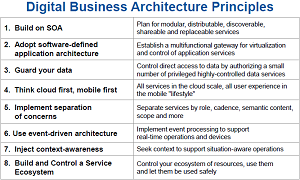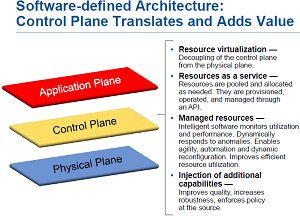News
Gartner: Get Moving on Software-Defined Architecture or Get Left Behind
'Standing still is not really an option.'
Spawning from the seed of software-defined networking (SDN) six years ago are new classes of encapsulated technology leading to new capabilities that are limited only by imagination, a Gartner Inc. analyst said yesterday.
But regardless of the possible innovations, it's imperative that companies today don't adhere to the status quo while competitors take advantage of the new opportunities.
"Standing still is not really an option," said Gartner analyst Yefim V. Natis in a webinar about software-defined architecture (SDA) and application design. "You can always postpone change, you can always be skeptical about the discussions of the necessary change. But we believe that continuing to apply the old familiar but expiring principles of application design is a very poor service by you to your organization, your business and your IT, in that what you're creating by doing this is applications that are instantly legacy, applications that are legacy before you even finish them."
Natis went on to discuss eight principles organizations should follow as they step up to the new world of application architecture in the age of digital business, which is especially impacted by the emerging Internet of Things (IoT). Other driving forces are the intersections of trends such as mobility, cloud computing, social engagement and information -- essentially Big Data analytics.
Being a digital business means everything operates through digital means, Natis said, from interactions with customers and partners to planning, manufacturing, business optimization and more. "The creation of new business designs by blurring the digital and physical worlds creates an environment of digital business," he said.
 [Click on image for larger view.]
The Eight Principles (source: Gartner webinar)
[Click on image for larger view.]
The Eight Principles (source: Gartner webinar)
It all starts with a foundation built on traditional service-oriented architecture (SOA), Natis said, followed by:
- Moving to SDA for applications.
- Guarding your data.
- Thinking mobile-first for the front-end of business systems and thinking cloud-first for the back-end.
- Separating concerns.
- Using event-driven processing.
- Automating context management.
- Building and controlling a service ecosystem.
The advantages of SOA have made it nearly ubiquitous, the analyst explained, but along with the growth of services and the ability to combine and recombine them in different ways comes the danger of losing control of your services, applications and -- in the worst-case scenario -- your data.
This problem is addressed by SDA, which is built on SOA but adds another flavor to it. "Meanwhile there is this thing that's been emerging outside of the space of software architecture, which is software-defined this and that," he said.
It all started with SDN, developed at UC Berkeley and Stanford University in 2008.
"It was followed later by the notion of a software-defined datacenter, more recently software-defined storage," he said. "And in all of these cases, what is happening is the evolution of the idea of virtualization essentially, where you take ... a certain kind of hardware, you wrap it with software that encapsulates that hardware, so the applications outside no longer have to be locked into particular APIs or particular hardware."
Rather, he said, the software-defined technologies let organizations use a more generic model of APIs that provide encapsulation, behind which you can change hardware or combine hardware of different types without affecting related applications.
"Most recently, this year, we heard of the emergence of a thing called software-defined security perimeter," Natis continued. "In this case, you have this encapsulation that is no longer of hardware, but rather of software. And, of course, if you think about it, why does it have to be hardware? The principle is the same. You wrap a complex environment so you can manage it independently of the outside world that depends on its functionality. It makes sense in many ways. So what this control plane in the middle provides is the virtualization of resources."
These resources, consisting of hardware, software or whatever, can be converged into collections of services that are easily managed by an intermediary control plane. With easier management comes the ability to more easily add value.
 [Click on image for larger view.]
Adding Value (source: Gartner webinar)
[Click on image for larger view.]
Adding Value (source: Gartner webinar)
"You can now take charge of all these interactions, you can add security, monitoring for compliance and fraud. You can inject context if you want. You can inject the application integration and orchestration into the interaction with your services. The list goes on and on. It's really up to your imagination of what you can do with this intermediary layer to enrich the use of this control of services that you have," Natis explained.
After expounding upon the eight principles, Natis advised that the process of becoming a digital business must start with cultural change, starting with changing the attitudes of people. Staffers need to think openly, socialize and listen to others, crowdsource and be transparent, fight the "not-invented-here syndrome" and avoid fiefdoms and stovepipes, while experimenting and being systematically opportunistic.
Natis also had some warnings, starting with the caution to start slowly. Organizations must "curb your new architecture enthusiasm," he said, being realistic and recognizing these changes might take years. They should evolve gradually and organizations should first decide how to measure the success of such initiatives so it can be effectively gauged and evaluated.
Nevertheless, it's important to get started on the change. Such evolutions are typically led by leading-edge companies with vast resources, but now everyone needs to get on board. "It's not really a privilege of those that can afford thinking long term," he said. "It is imperative for everyone to understand and follow principles of architecture that ... produce applications that meet the requirements of modern business."
About the Author
David Ramel is an editor and writer at Converge 360.